2017 NISSAN VERSA NOTE oil type
[x] Cancel search: oil typePage 91 of 414
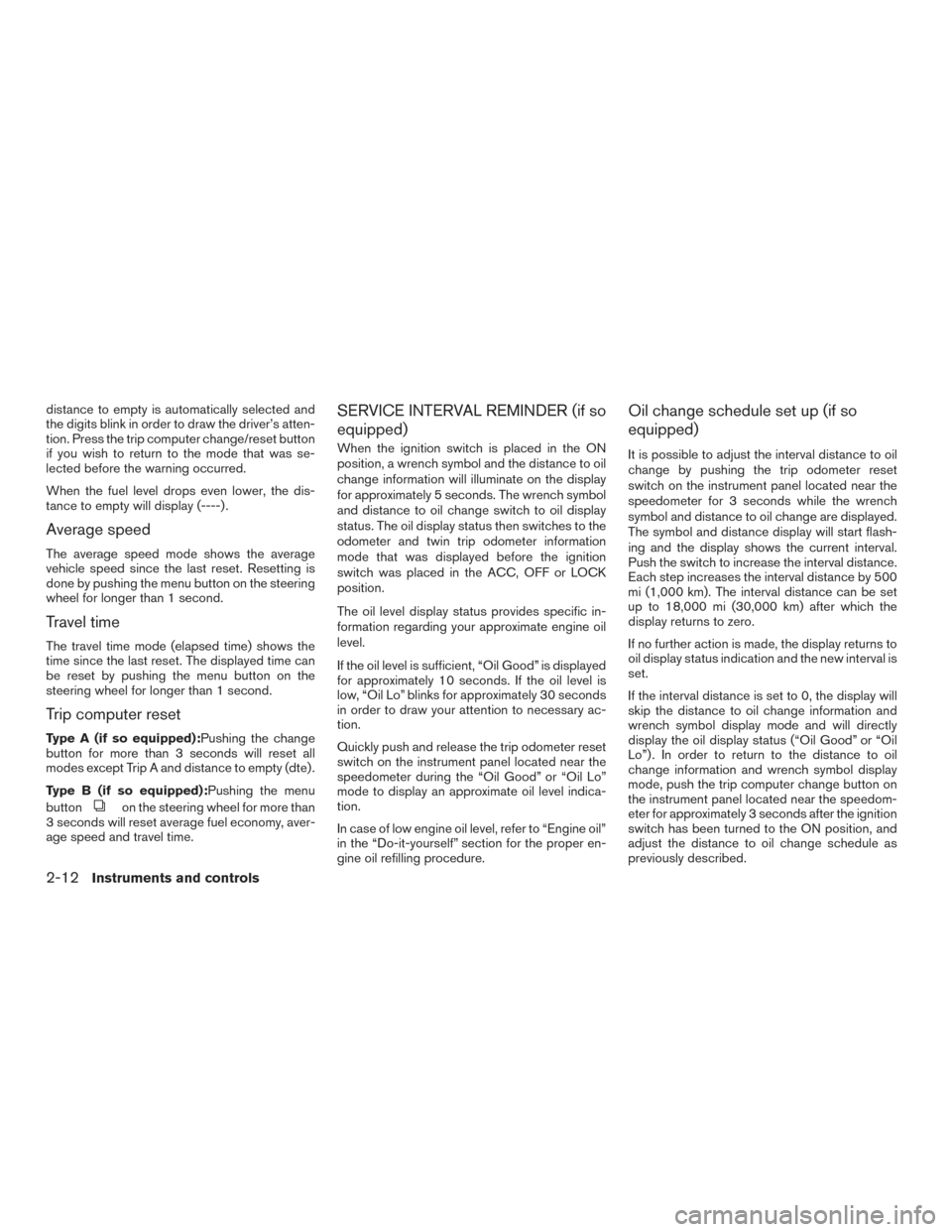
distance to empty is automatically selected and
the digits blink in order to draw the driver’s atten-
tion. Press the trip computer change/reset button
if you wish to return to the mode that was se-
lected before the warning occurred.
When the fuel level drops even lower, the dis-
tance to empty will display (----) .
Average speed
The average speed mode shows the average
vehicle speed since the last reset. Resetting is
done by pushing the menu button on the steering
wheel for longer than 1 second.
Travel time
The travel time mode (elapsed time) shows the
time since the last reset. The displayed time can
be reset by pushing the menu button on the
steering wheel for longer than 1 second.
Trip computer reset
Type A (if so equipped):Pushing the change
button for more than 3 seconds will reset all
modes except Trip A and distance to empty (dte) .
Type B (if so equipped):Pushing the menu
button
on the steering wheel for more than
3 seconds will reset average fuel economy, aver-
age speed and travel time.
SERVICE INTERVAL REMINDER (if so
equipped)
When the ignition switch is placed in the ON
position, a wrench symbol and the distance to oil
change information will illuminate on the display
for approximately 5 seconds. The wrench symbol
and distance to oil change switch to oil display
status. The oil display status then switches to the
odometer and twin trip odometer information
mode that was displayed before the ignition
switch was placed in the ACC, OFF or LOCK
position.
The oil level display status provides specific in-
formation regarding your approximate engine oil
level.
If the oil level is sufficient, “Oil Good” is displayed
for approximately 10 seconds. If the oil level is
low, “Oil Lo” blinks for approximately 30 seconds
in order to draw your attention to necessary ac-
tion.
Quickly push and release the trip odometer reset
switch on the instrument panel located near the
speedometer during the “Oil Good” or “Oil Lo”
mode to display an approximate oil level indica-
tion.
In case of low engine oil level, refer to “Engine oil”
in the “Do-it-yourself” section for the proper en-
gine oil refilling procedure.
Oil change schedule set up (if so
equipped)
It is possible to adjust the interval distance to oil
change by pushing the trip odometer reset
switch on the instrument panel located near the
speedometer for 3 seconds while the wrench
symbol and distance to oil change are displayed.
The symbol and distance display will start flash-
ing and the display shows the current interval.
Push the switch to increase the interval distance.
Each step increases the interval distance by 500
mi (1,000 km). The interval distance can be set
up to 18,000 mi (30,000 km) after which the
display returns to zero.
If no further action is made, the display returns to
oil display status indication and the new interval is
set.
If the interval distance is set to 0, the display will
skip the distance to oil change information and
wrench symbol display mode and will directly
display the oil display status (“Oil Good” or “Oil
Lo”) . In order to return to the distance to oil
change information and wrench symbol display
mode, push the trip computer change button on
the instrument panel located near the speedom-
eter for approximately 3 seconds after the ignition
switch has been turned to the ON position, and
adjust the distance to oil change schedule as
previously described.
2-12Instruments and controls
Page 323 of 414
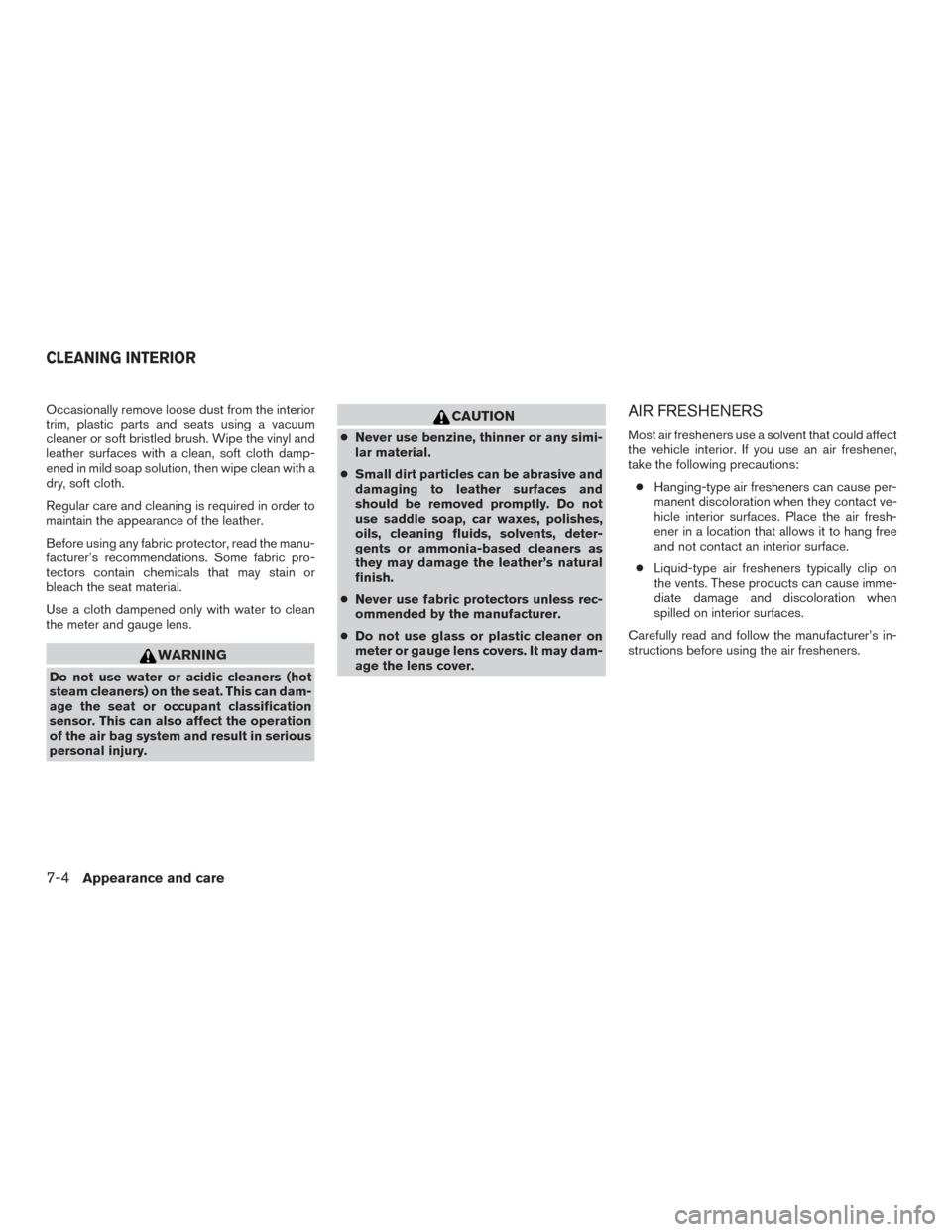
Occasionally remove loose dust from the interior
trim, plastic parts and seats using a vacuum
cleaner or soft bristled brush. Wipe the vinyl and
leather surfaces with a clean, soft cloth damp-
ened in mild soap solution, then wipe clean with a
dry, soft cloth.
Regular care and cleaning is required in order to
maintain the appearance of the leather.
Before using any fabric protector, read the manu-
facturer’s recommendations. Some fabric pro-
tectors contain chemicals that may stain or
bleach the seat material.
Use a cloth dampened only with water to clean
the meter and gauge lens.
WARNING
Do not use water or acidic cleaners (hot
steam cleaners) on the seat. This can dam-
age the seat or occupant classification
sensor. This can also affect the operation
of the air bag system and result in serious
personal injury.
CAUTION
●Never use benzine, thinner or any simi-
lar material.
● Small dirt particles can be abrasive and
damaging to leather surfaces and
should be removed promptly. Do not
use saddle soap, car waxes, polishes,
oils, cleaning fluids, solvents, deter-
gents or ammonia-based cleaners as
they may damage the leather’s natural
finish.
● Never use fabric protectors unless rec-
ommended by the manufacturer.
● Do not use glass or plastic cleaner on
meter or gauge lens covers. It may dam-
age the lens cover.
AIR FRESHENERS
Most air fresheners use a solvent that could affect
the vehicle interior. If you use an air freshener,
take the following precautions:
● Hanging-type air fresheners can cause per-
manent discoloration when they contact ve-
hicle interior surfaces. Place the air fresh-
ener in a location that allows it to hang free
and not contact an interior surface.
● Liquid-type air fresheners typically clip on
the vents. These products can cause imme-
diate damage and discoloration when
spilled on interior surfaces.
Carefully read and follow the manufacturer’s in-
structions before using the air fresheners.
CLEANING INTERIOR
7-4Appearance and care
Page 328 of 414
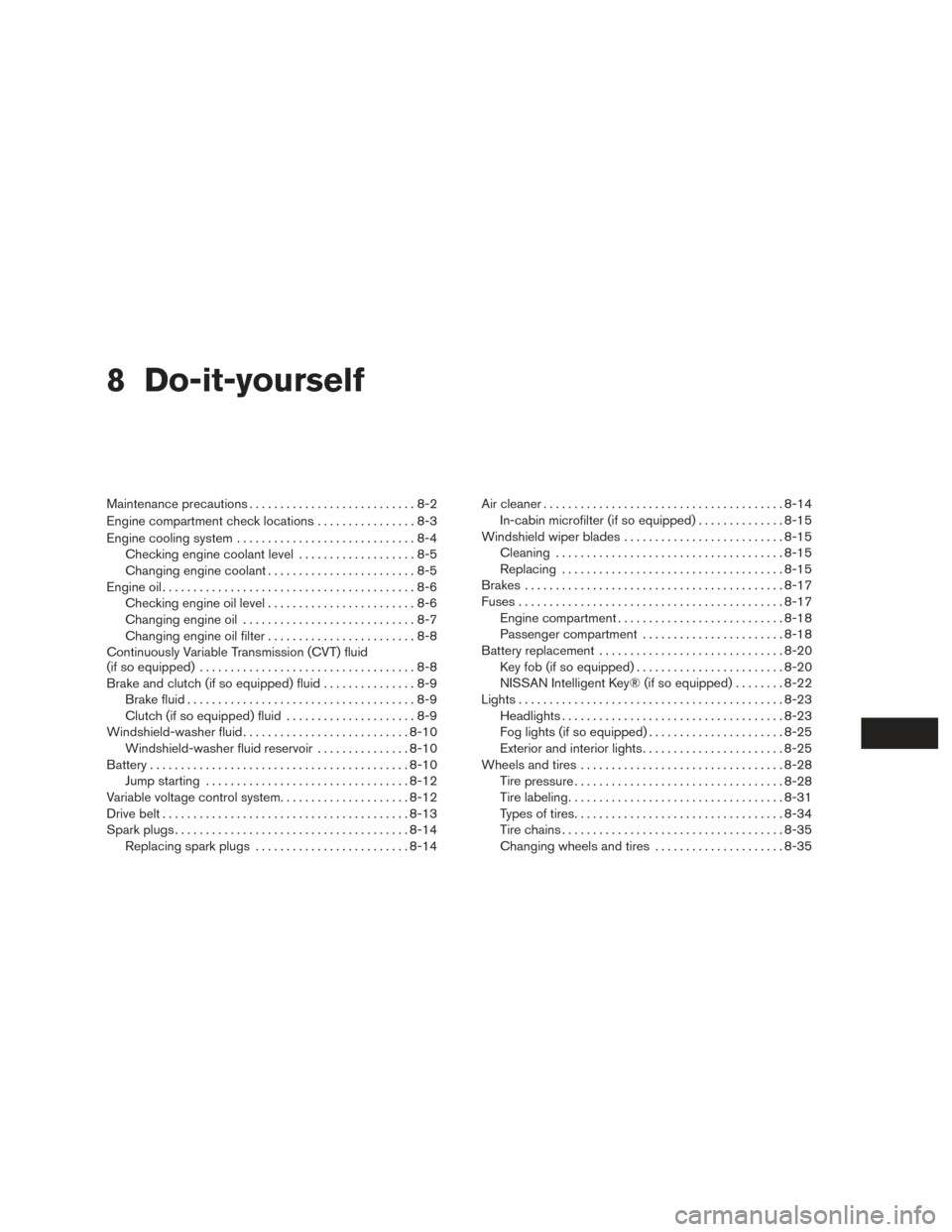
8 Do-it-yourself
Maintenance precautions...........................8-2
Engine compartment check locations ................8-3
Engine cooling system .............................8-4
Checking engine coolant level ...................8-5
Changing engine coolant ........................8-5
Engine oil .........................................8-6
Checking engine oil level ........................8-6
Changing engine oil ............................8-7
Changing engine oil filter ........................8-8
Continuously Variable Transmission (CVT) fluid
(if so equipped) ...................................8-8
Brake and clutch (if so equipped) fluid ...............8-9
Brake fluid .....................................8-9
Clutch (if so equipped) fluid .....................8-9
Windshield-washer fluid ........................... 8-10
Windshield-washer fluid reservoir ...............8-10
Battery .......................................... 8-10
Jump starting ................................. 8-12
Variable voltage control system .....................8-12
Drive belt ........................................ 8-13
Spark plugs ...................................... 8-14
Replacing spark plugs ......................... 8-14Air cleaner
....................................... 8-14
In-cabin microfilter (if so equipped) ..............8-15
Windshield wiper blades .......................... 8-15
Cleaning ..................................... 8-15
Replacing .................................... 8-15
Brakes .......................................... 8-17
Fuses ........................................... 8-17
Engine compartment ........................... 8-18
Passenger compartment .......................8-18
Battery replacement .............................. 8-20
Key fob (if so equipped) ........................ 8-20
NISSAN Intelligent Key® (if so equipped) ........8-22
Lights ........................................... 8-23
Headlights .................................... 8-23
Fog lights (if so equipped) ......................8-25
Exterior and interior lights .......................8-25
Wheels and tires ................................. 8-28
Tire pressure .................................. 8-28
Tire
labeling ................................... 8-31
Types of tires .................................. 8-34
Tire chains .................................... 8-35
Changing wheels and tires .....................8-35
Page 373 of 414
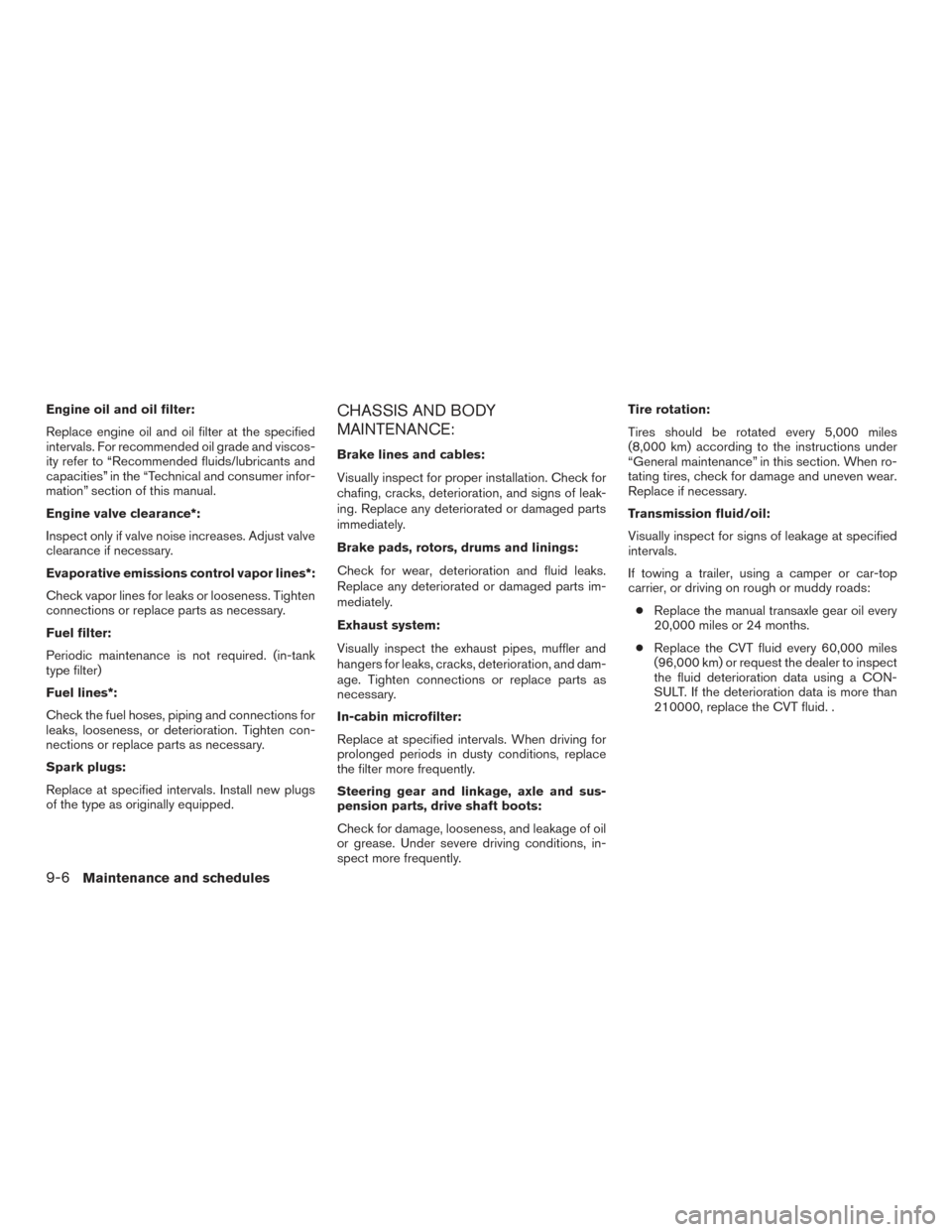
Engine oil and oil filter:
Replace engine oil and oil filter at the specified
intervals. For recommended oil grade and viscos-
ity refer to “Recommended fluids/lubricants and
capacities” in the “Technical and consumer infor-
mation” section of this manual.
Engine valve clearance*:
Inspect only if valve noise increases. Adjust valve
clearance if necessary.
Evaporative emissions control vapor lines*:
Check vapor lines for leaks or looseness. Tighten
connections or replace parts as necessary.
Fuel filter:
Periodic maintenance is not required. (in-tank
type filter)
Fuel lines*:
Check the fuel hoses, piping and connections for
leaks, looseness, or deterioration. Tighten con-
nections or replace parts as necessary.
Spark plugs:
Replace at specified intervals. Install new plugs
of the type as originally equipped.CHASSIS AND BODY
MAINTENANCE:
Brake lines and cables:
Visually inspect for proper installation. Check for
chafing, cracks, deterioration, and signs of leak-
ing. Replace any deteriorated or damaged parts
immediately.
Brake pads, rotors, drums and linings:
Check for wear, deterioration and fluid leaks.
Replace any deteriorated or damaged parts im-
mediately.
Exhaust system:
Visually inspect the exhaust pipes, muffler and
hangers for leaks, cracks, deterioration, and dam-
age. Tighten connections or replace parts as
necessary.
In-cabin microfilter:
Replace at specified intervals. When driving for
prolonged periods in dusty conditions, replace
the filter more frequently.
Steering gear and linkage, axle and sus-
pension parts, drive shaft boots:
Check for damage, looseness, and leakage of oil
or grease. Under severe driving conditions, in-
spect more frequently.Tire rotation:
Tires should be rotated every 5,000 miles
(8,000 km) according to the instructions under
“General maintenance” in this section. When ro-
tating tires, check for damage and uneven wear.
Replace if necessary.
Transmission fluid/oil:
Visually inspect for signs of leakage at specified
intervals.
If towing a trailer, using a camper or car-top
carrier, or driving on rough or muddy roads:
● Replace the manual transaxle gear oil every
20,000 miles or 24 months.
● Replace the CVT fluid every 60,000 miles
(96,000 km) or request the dealer to inspect
the fluid deterioration data using a CON-
SULT. If the deterioration data is more than
210000, replace the CVT fluid. .
9-6Maintenance and schedules
Page 375 of 414
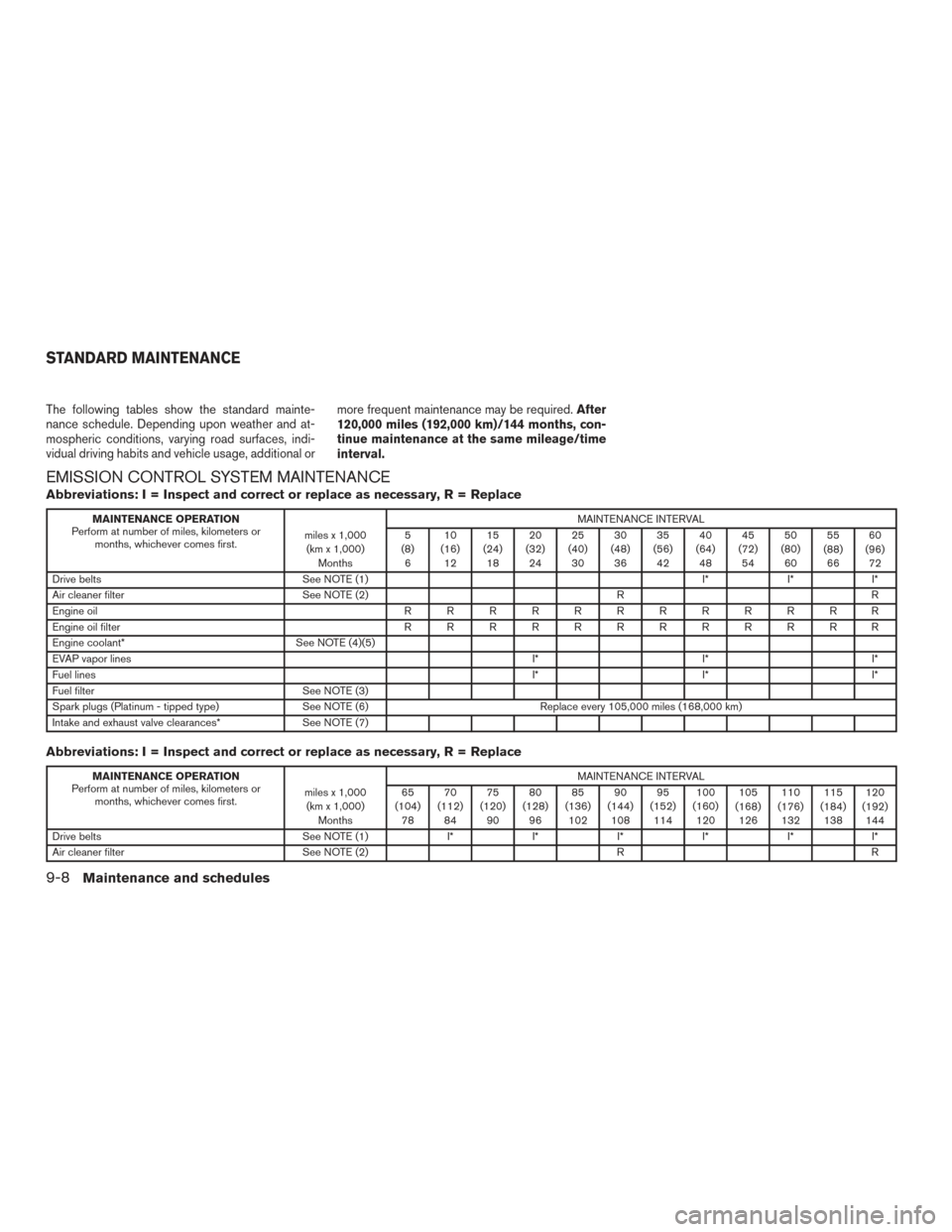
The following tables show the standard mainte-
nance schedule. Depending upon weather and at-
mospheric conditions, varying road surfaces, indi-
vidual driving habits and vehicle usage, additional ormore frequent maintenance may be required.
After
120,000 miles (192,000 km)/144 months, con-
tinue maintenance at the same mileage/time
interval.
EMISSION CONTROL SYSTEM MAINTENANCE
Abbreviations: I = Inspect and correct or replace as necessary, R = Replace
MAINTENANCE OPERATION
Perform at number of miles, kilometers or months, whichever comes first. miles x 1,000
(km x 1,000) Months MAINTENANCE INTERVAL
5
(8) 6 10
(16) 12 15
(24) 18 20
(32) 24 25
(40) 30 30
(48) 36 35
(56) 42 40
(64) 48 45
(72) 54 50
(80) 60 55
(88) 66 60
(96) 72
Drive belts See NOTE (1) I*I*I*
Air cleaner filter See NOTE (2) RR
Engine oil RRRRRRRRRRRR
Engine oil filter RRRRRRRRRRRR
Engine coolant* See NOTE (4)(5)
EVAP vapor lines I*I*I*
Fuel lines I*I*I*
Fuel filter See NOTE (3)
Spark plugs (Platinum - tipped type) See NOTE (6)Replace every 105,000 miles (168,000 km)
Intake and exhaust valve clearances* See NOTE (7)
Abbreviations: I = Inspect and correct or replace as necessary, R = Replace
MAINTENANCE OPERATION
Perform at number of miles, kilometers or months, whichever comes first. miles x 1,000
(km x 1,000) Months MAINTENANCE INTERVAL
65
(104) 78 70
(112) 84 75
(120) 90 80
(128) 96 85
(136) 102 90
(144) 108 95
(152) 114 100
(160) 120 105
(168) 126 110
(176) 132 115
(184) 138 120
(192) 144
Drive belts See NOTE (1)I*I*I*I*I*I*
Air cleaner filter See NOTE (2) RR
STANDARD MAINTENANCE
9-8Maintenance and schedules
Page 376 of 414
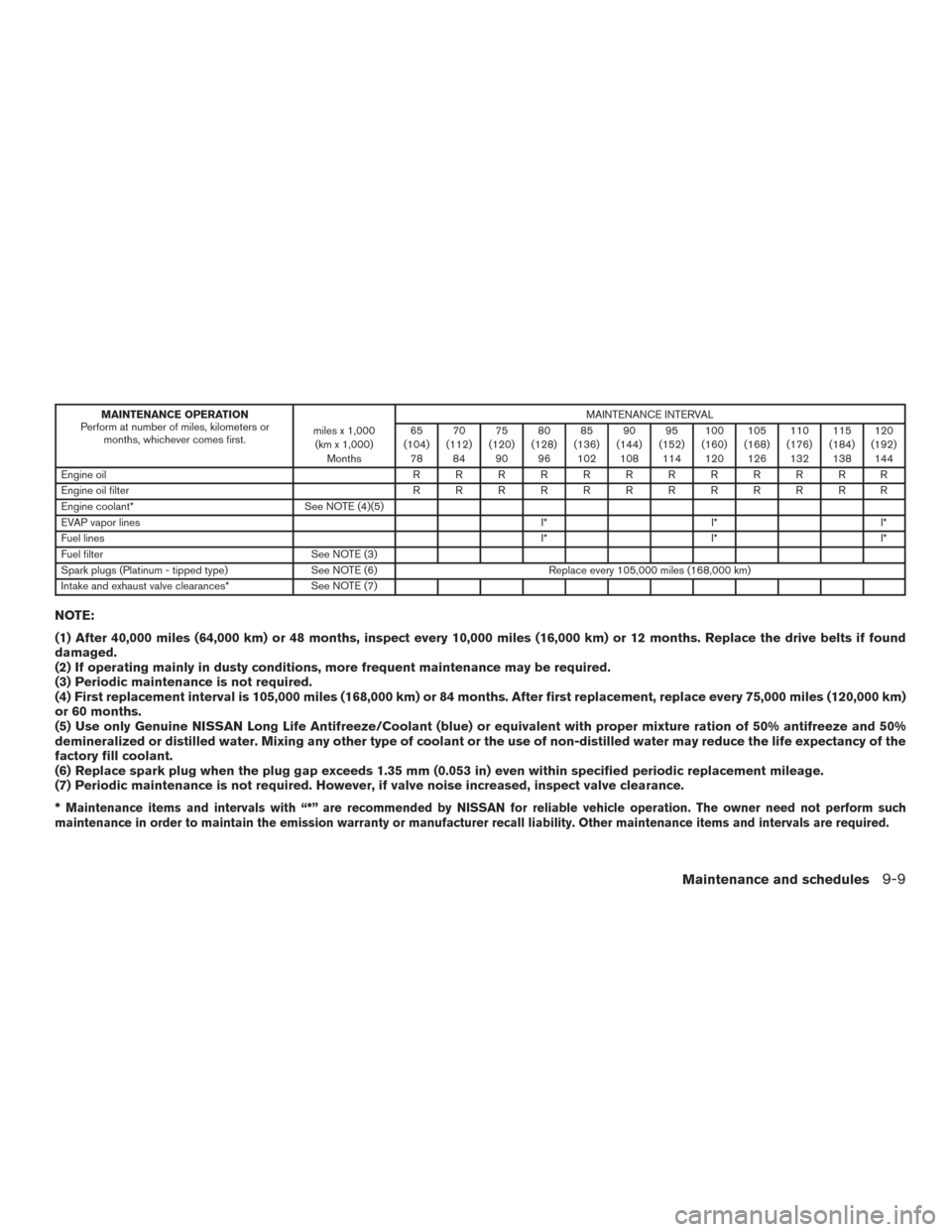
MAINTENANCE OPERATION
Perform at number of miles, kilometers or months, whichever comes first. miles x 1,000
(km x 1,000) Months MAINTENANCE INTERVAL
65
(104) 78 70
(112) 84 75
(120) 90 80
(128) 96 85
(136) 102 90
(144) 108 95
(152) 114 100
(160) 120 105
(168) 126 110
(176) 132 115
(184) 138 120
(192) 144
Engine oil RRRRRRRRRRRR
Engine oil filter RRRRRRRRRRRR
Engine coolant* See NOTE (4)(5)
EVAP vapor lines I*I*I*
Fuel lines I*I*I*
Fuel filter See NOTE (3)
Spark plugs (Platinum - tipped type) See NOTE (6)Replace every 105,000 miles (168,000 km)
Intake and exhaust valve clearances* See NOTE (7)
NOTE:
(1) After 40,000 miles (64,000 km) or 48 months, inspect every 10,000 miles (16,000 km) or 12 months. Replace the drive belts if found
damaged.
(2) If operating mainly in dusty conditions, more frequent maintenance may be required.
(3) Periodic maintenance is not required.
(4) First replacement interval is 105,000 miles (168,000 km) or 84 months. After first replacement, replace every 75,000 miles (120,000 km)
or 60 months.
(5) Use only Genuine NISSAN Long Life Antifreeze/Coolant (blue) or equivalent with proper mixture ration of 50% antifreeze and 50%
demineralized or distilled water. Mixing any other type of coolant or the use of non-distilled water may reduce the life expectancy of the
factory fill coolant.
(6) Replace spark plug when the plug gap exceeds 1.35 mm (0.053 in) even within specified periodic replacement mileage.
(7) Periodic maintenance is not required. However, if valve noise increased, inspect valve clearance.
*
Maintenance items and intervals with “*” are recommended by NISSAN for reliable vehicle operation. The owner need not perform such
maintenance in order to maintain the emission warranty or manufacturer recall liability. Other maintenance items and intervals are required.
Maintenance and schedules9-9
Page 385 of 414
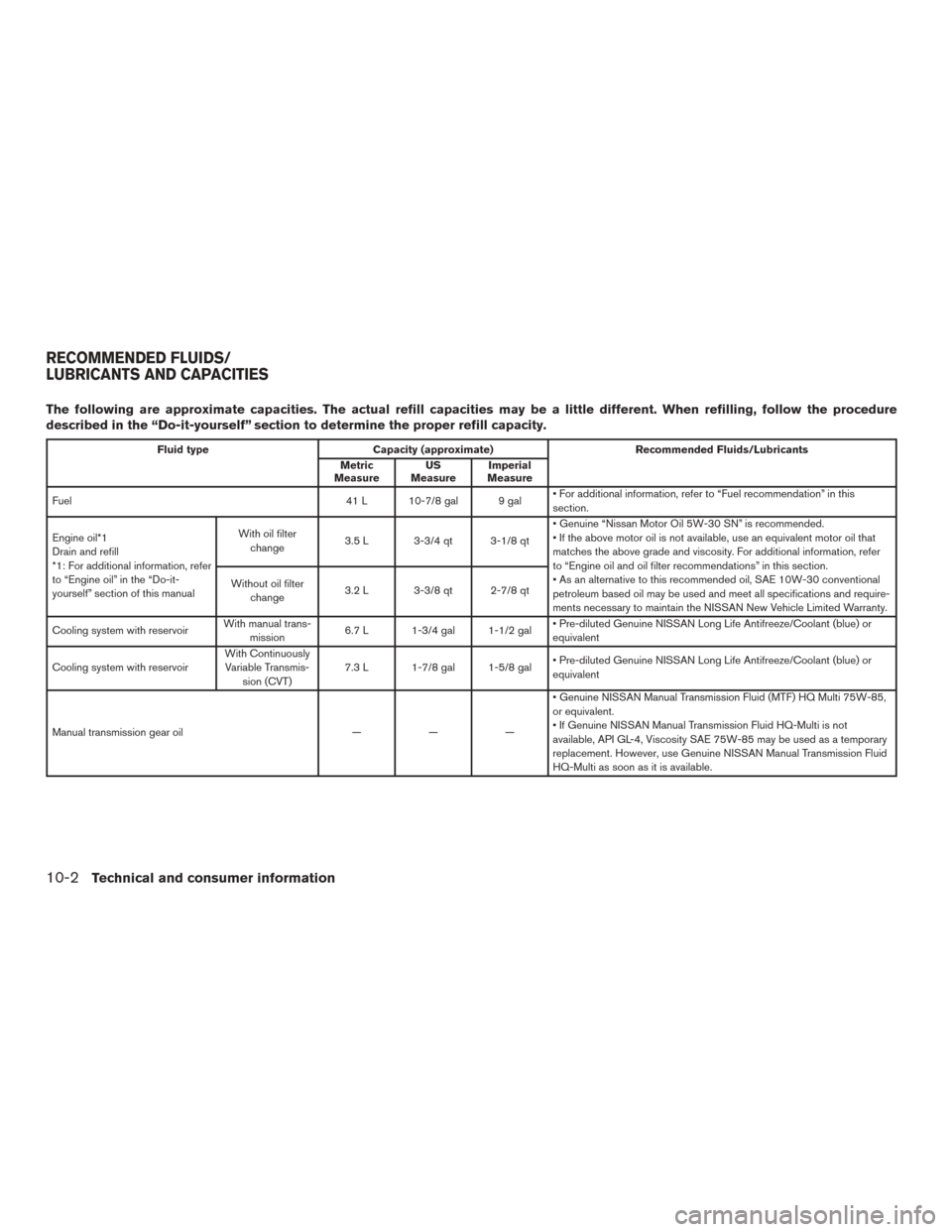
The following are approximate capacities. The actual refill capacities may be a little different. When refilling, follow the procedure
described in the “Do-it-yourself” section to determine the proper refill capacity.
Fluid typeCapacity (approximate) Recommended Fluids/Lubricants
Metric
Measure US
Measure Imperial
Measure
Fuel 41 L 10-7/8 gal 9 gal• For additional information, refer to “Fuel recommendation” in this
section.
Engine oil*1
Drain and refill
*1: For additional information, refer
to “Engine oil” in the “Do-it-
yourself” section of this manual With oil filter
change 3.5 L 3-3/4 qt 3-1/8 qt • Genuine “Nissan Motor Oil 5W-30 SN” is recommended.
• If the above motor oil is not available, use an equivalent motor oil that
matches the above grade and viscosity. For additional information, refer
to “Engine oil and oil filter recommendations” in this section.
• As an alternative to this recommended oil, SAE 10W-30 conventional
petroleum based oil may be used and meet all specifications and require-
ments necessary to maintain the NISSAN New Vehicle Limited Warranty.
Without oil filter
change 3.2 L 3-3/8 qt 2-7/8 qt
Cooling system with reservoir With manual trans-
mission 6.7 L 1-3/4 gal 1-1/2 gal • Pre-diluted Genuine NISSAN Long Life Antifreeze/Coolant (blue) or
equivalent
Cooling system with reservoir With Continuously
Variable Transmis- sion (CVT) 7.3 L 1-7/8 gal 1-5/8 gal
• Pre-diluted Genuine NISSAN Long Life Antifreeze/Coolant (blue) or
equivalent
Manual transmission gear oil ———• Genuine NISSAN Manual Transmission Fluid (MTF) HQ Multi 75W-85,
or equivalent.
• If Genuine NISSAN Manual Transmission Fluid HQ-Multi is not
available, API GL-4, Viscosity SAE 75W-85 may be used as a temporary
replacement. However, use Genuine NISSAN Manual Transmission Fluid
HQ-Multi as soon as it is available.
RECOMMENDED FLUIDS/
LUBRICANTS AND CAPACITIES
10-2Technical and consumer information
Page 386 of 414
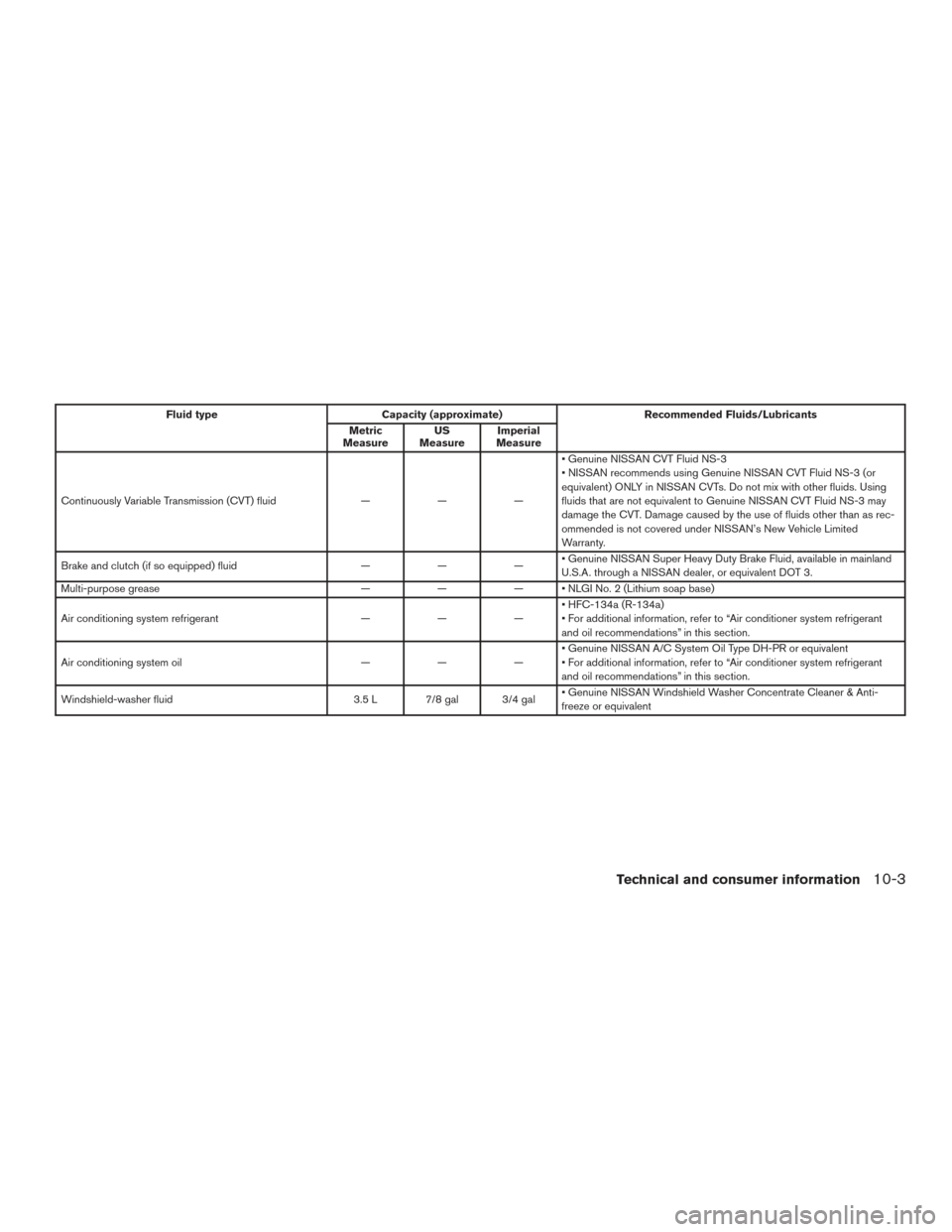
Fluid typeCapacity (approximate) Recommended Fluids/Lubricants
Metric
Measure US
Measure Imperial
Measure
Continuously Variable Transmission (CVT) fluid ———• Genuine NISSAN CVT Fluid NS-3
• NISSAN recommends using Genuine NISSAN CVT Fluid NS-3 (or
equivalent) ONLY in NISSAN CVTs. Do not mix with other fluids. Using
fluids that are not equivalent to Genuine NISSAN CVT Fluid NS-3 may
damage the CVT. Damage caused by the use of fluids other than as rec-
ommended is not covered under NISSAN’s New Vehicle Limited
Warranty.
Brake and clutch (if so equipped) fluid ———• Genuine NISSAN Super Heavy Duty Brake Fluid, available in mainland
U.S.A. through a NISSAN dealer, or equivalent DOT 3.
Multi-purpose grease ——— • NLGI No. 2 (Lithium soap base)
Air conditioning system refrigerant ———• HFC-134a (R-134a)
• For additional information, refer to “Air conditioner system refrigerant
and oil recommendations” in this section.
Air conditioning system oil ———• Genuine NISSAN A/C System Oil Type DH-PR or equivalent
• For additional information, refer to “Air conditioner system refrigerant
and oil recommendations” in this section.
Windshield-washer fluid 3.5 L 7/8 gal 3/4 gal• Genuine NISSAN Windshield Washer Concentrate Cleaner & Anti-
freeze or equivalent
Technical and consumer information10-3